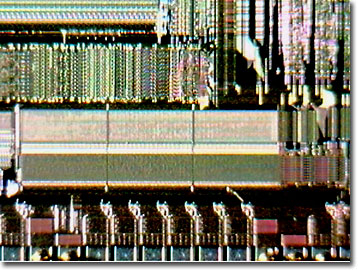Integrated Circuit Image Gallery
Intel 487SX Math Coprocessor
Released in the early 1990s as a math coprocessor for personal computers, the Intel 487SX provided the missing floating-point unit (FPU) for the 486SX microprocessor. In actuality, the 487SX is a version of the much more expensive and functional Intel 486DX processor outfitted with an extra pin so that it fits into the coprocessor socket.

View a second image of the Intel 487SX Math Coprocessor.
Although completely disabled when a 487SX chip is installed, the motherboard design demands that the 486SX processor remain in place in the PC. Intel engineers probably created this unusual feature so that the less powerful, original issue chip would not be used in another machine, and thereby lower demand for their upgrade chips. In a real marketing coup, uninformed computer users did not know that they purchased and installed the much more powerful 486DX microprocessor in their computers.
Intel admitted that in some systems, the 486SX could be unplugged and replaced with the 487SX in its place on the motherboard, but they would not guarantee that it would always work. As with the 486DX, the 487SX featured 1.2 million transistors with an internal floating-point unit and an 8-kbyte cache memory. As an alternative to the math coprocessor, a 486-overdrive chip was marketed that installed into the 487SX socket and provided faster main processor functions while disabling the original 486SX chip. In a manner similar to the 486SXs, Intel released 25 MHz and 33 MHz-clock-speed versions of the 487SX. Although Intel licensed other manufacturers to fabricate its central processing units, the 487SX and other math coprocessor designs were retained solely by the parent company. The same 169-pin pin-grid array (PGA) socket designed for the Intel 487SX math coprocessor accepted 168-pin upgrade processors such as the 486DX2, DX4, and the AMD or Cyrix 5x86.
Contributing Authors
Omar Alvarado, Thomas J. Fellers and Michael W. Davidson - National High Magnetic Field Laboratory, 1800 East Paul Dirac Dr., The Florida State University, Tallahassee, Florida, 32310.
BACK TO THE INTEGRATED CIRCUIT IMAGE GALLERY
BACK TO THE DIGITAL IMAGE GALLERIES
Questions or comments? Send us an email.
© 1995-2025 by Michael W. Davidson and The Florida State University. All Rights Reserved. No images, graphics, software, scripts, or applets may be reproduced or used in any manner without permission from the copyright holders. Use of this website means you agree to all of the Legal Terms and Conditions set forth by the owners.
This website is maintained by our
Graphics & Web Programming Team
in collaboration with Optical Microscopy at the
National High Magnetic Field Laboratory.
Last Modification Friday, Nov 13, 2015 at 01:19 PM
Access Count Since September 17, 2002: 13626
Visit the website of our partner in introductory microscopy education:
|
|
